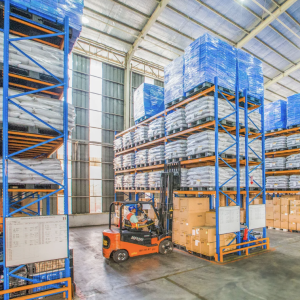What is Intralogistics?
Simply stated, intralogistics is the management of operations (“logistics”) within (“intra”) a warehouse. You can think of it as “inside logistics.” More broadly speaking, intralogistics refers to the optimization of all planning and movement of materials and information inside a distribution center or warehouse, from the moment of arrival at the dock door to the time it is picked, packed, and shipped. While the term intralogistics is fairly new, the concept has existed for millennia, since early agrarian societies first began storing and distributing food. While there is overlap with the more common term, “material handling,” which refers to the movement, storage, and disposal of material goods, intralogistics is both more specific to warehouse & fulfillment operations and broad to include expertise, telematics, design, and engineering.
Why does intralogistics matter?
If you look around your office or your home, almost everything you see required sophisticated intralogistics to get from where it was manufactured (often Asia) to your door. The supply chain is complicated. Often, components are manufactured and stored then moved elsewhere for assembly, possibly in multiple steps at multiple facilities in multiple countries. Components and, later, whole goods, are generally stored in a fulfillment center and then picked and shipped when an order is placed. This can be bulk orders from businesses or one-off orders from consumers. Many fulfillment centers have thousands of individual SKUs that must be organized, stored, picked, and shipped efficiently. It is complex and getting more so every day! Not to mention, you or someone you know likely works in intralogistics or the broader supply chain. According to Harvard Business Review, “The U.S. supply chain contains 37% of all jobs, employing 44 million people.”
Why are people talking about intralogistics now?
According to McKinsey & Company, the top three global supply chain challenges are:
- Labor shortages
- Lack of equipment
- Bottlenecks of goods at ports
As the world has discovered during the COVID-19 pandemic, a complicated supply chain means multiple opportunities for failure. For myriad reasons (Beijing shutdowns, specific component shortfalls, etc.), the lead time for components and goods manufactured overseas increased dramatically for U.S.-based businesses and consumers. At the same time, U.S. consumers found themselves at home with low cost of debt, soaring asset portfolios (before the 2022 declines), and the entire world of shopping available at their fingertips. Ecommerce skyrocketed, further straining supply chain. Entrepreneurs tapped into direct marketing channels to launch new brands, fragmenting marketplaces, and causing a further explosion of SKUs (distinct goods) consumers can buy and information flows to manage.
To meet this demand and insulate themselves from supply chain shocks, businesses are shifting toward nearshoring (bringing manufacturing and distribution to a nearby country) and onshoring (bringing it within domestic borders). Third-party logistics companies (3PLs) are growing rapidly as businesses increasingly outsource their fulfillment, which necessitates the quick physical expansion of warehousing and hiring of warehouse employees – all at a time when the unemployment rate is historically low.
According to Statistia, “since 2010, the number of warehousing and storage businesses in the US has been growing at an increasing rate every year, reaching 19,190 in 2020. This compares to 15,152 in 2010.” This means more people with less experience need to be hired and onboarded and able to operate more efficiently than ever be. Intralogistics is the art of making that happen, of ensuring the right people, systems, and equipment at the right place at the right time.
What does the future of intralogistics look like?
Experts are coming together to create a positive perception of this industry to bring in a new wave of talent for potential employees. This is especially true for younger generations and/or women, to help diversify an older, male-dominated industry. Women-owned companies like Bailey Equipment & Intralogistics and trade organizations like MHEDA are working to develop diverse talent.
Automation and semi-automation are being deployed at scale to make it easy for untrained and low skilled employees to operate efficiently. In stable, consistent, low-SKU operations, companies are going completely automated. In less predictable applications, or for companies desiring lower upfront investment, companies are using semi-automation so new employees can simply press a button on their turret truck and be taken seamlessly to their next pick. Goods-to-person robots are allowing companies to reorganize their picking, bringing pallets to the pickers rather than sending pickers to the pallets. Sortation robots are able to take mixed products, often via a conveyor system, and accurately and efficiently sort them based on orders. Already, automation is changing the game – and it is only the beginning.
Lastly, there’s a call to action to go green. As the first TRUE certified zero waste forklift dealership in the United States and business in Tennessee Bailey Equipment & Logistics is leading the charge toward sustainable operations. Increasingly, consumers demand transparency from supply chains. They want to know that the goods they consume were produced and moved with minimal impact, and it is imperative that companies recognize the impact of their actions and strive to minimize it.
What solutions are considered part of intralogistics?
Intralogistics equipment is a variety of manual, semi-automated, and automated equipment and systems. These include:
- Automated storage and retrieval systems (ASRS)
- Automated guided vehicles (AGVs)
- Autonomous mobile robots (AMRs)
- Conveyor systems
- Dock & door equipment and services
- Engineered systems & systems integration
- Integrated Material Handling Systems
- Item order fulfillment systems
- Lift tables
- Lift trucks / forklifts
- Monorails and workstation cranes
- Operations consulting
- Overhead cranes
- Racking
- Sortation robotics and systems
- Telematics and other automated data storage and collection
- Warehouse design & optimization
- Warehouse management systems (WMS)
- Warehouse products (guardrail, sweepers & scrubbers, mezzanines, modular offices, etc.)
Sources:
https://logistikknowhow.com/en/historical-development/the-beginning-of-logistics-and-intralogistics-2/
https://hbr.org/2018/03/the-supply-chain-economy-and-the-future-of-good-jobs-in-america
https://www.mhi.org/fundamentals/material-handling
https://www.statista.com/statistics/873492/total-number-of-warehouses-united-states/
https://www.mckinsey.com/industries/travel-logistics-and-infrastructure/our-insights/overcoming-global-supply-chain-challenges





